Decision Making in Capital Investment Appraisal
VerifiedAdded on 2023/01/11
|7
|1417
|78
AI Summary
This essay discusses the decision making process in capital investment appraisal and the factors that influence it. It covers the use of financial factors such as payback period and net present value, as well as non-financial factors like strong management team and growth potential. The essay concludes with the importance of decision making in maximizing organizational performance.
Contribute Materials
Your contribution can guide someone’s learning journey. Share your
documents today.

Individual Essay
Secure Best Marks with AI Grader
Need help grading? Try our AI Grader for instant feedback on your assignments.
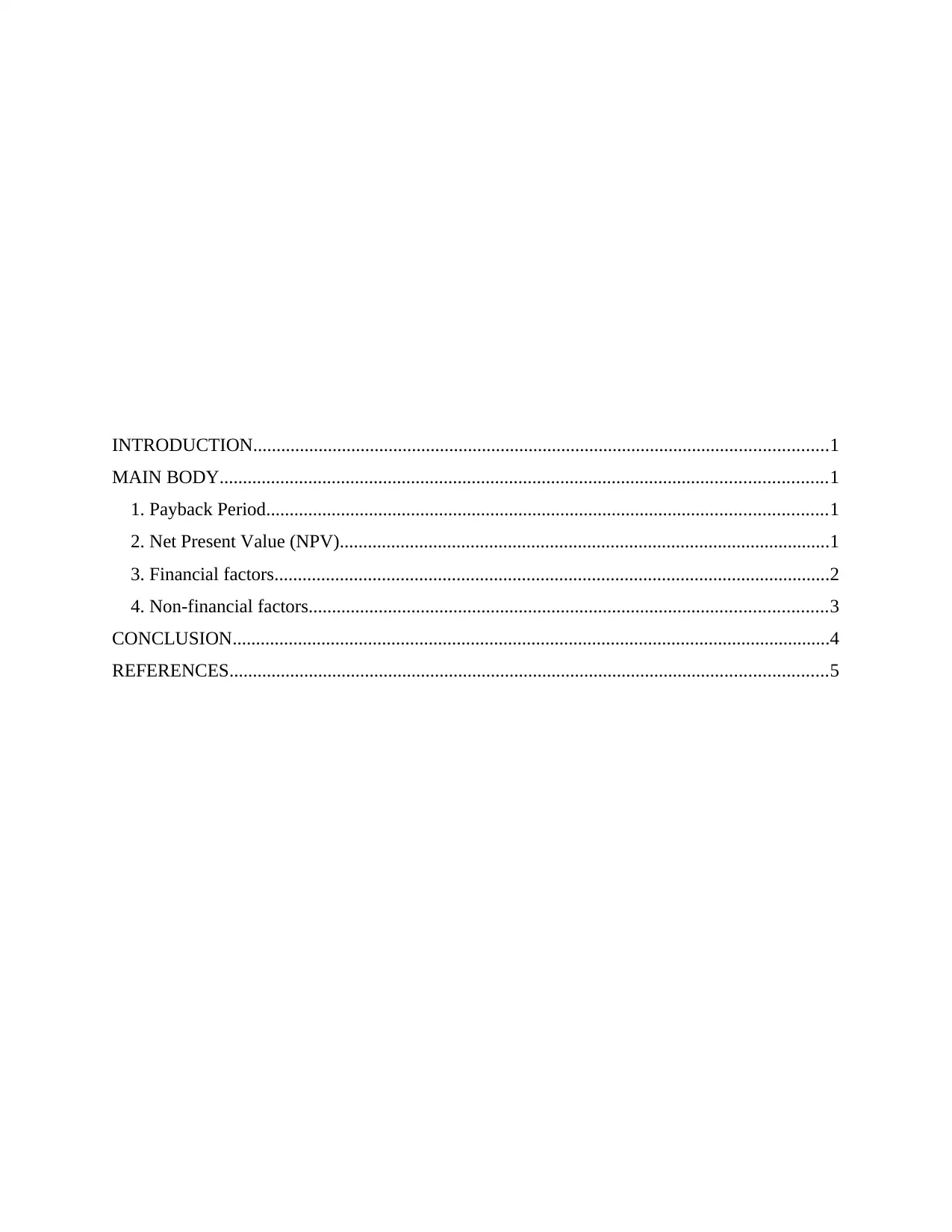
INTRODUCTION...........................................................................................................................1
MAIN BODY..................................................................................................................................1
1. Payback Period........................................................................................................................1
2. Net Present Value (NPV).........................................................................................................1
3. Financial factors.......................................................................................................................2
4. Non-financial factors...............................................................................................................3
CONCLUSION................................................................................................................................4
REFERENCES................................................................................................................................5
MAIN BODY..................................................................................................................................1
1. Payback Period........................................................................................................................1
2. Net Present Value (NPV).........................................................................................................1
3. Financial factors.......................................................................................................................2
4. Non-financial factors...............................................................................................................3
CONCLUSION................................................................................................................................4
REFERENCES................................................................................................................................5
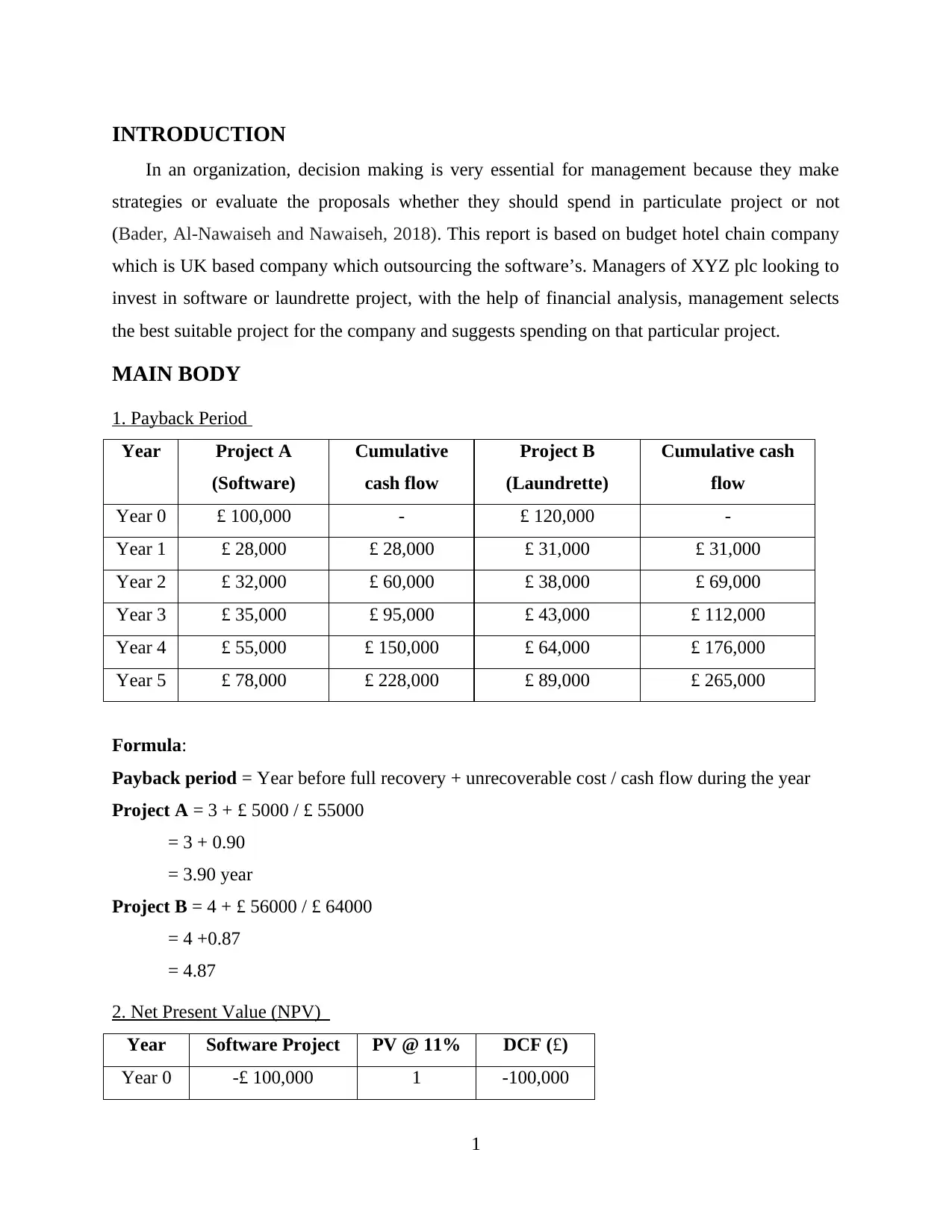
INTRODUCTION
In an organization, decision making is very essential for management because they make
strategies or evaluate the proposals whether they should spend in particulate project or not
(Bader, Al-Nawaiseh and Nawaiseh, 2018). This report is based on budget hotel chain company
which is UK based company which outsourcing the software’s. Managers of XYZ plc looking to
invest in software or laundrette project, with the help of financial analysis, management selects
the best suitable project for the company and suggests spending on that particular project.
MAIN BODY
1. Payback Period
Year Project A
(Software)
Cumulative
cash flow
Project B
(Laundrette)
Cumulative cash
flow
Year 0 £ 100,000 - £ 120,000 -
Year 1 £ 28,000 £ 28,000 £ 31,000 £ 31,000
Year 2 £ 32,000 £ 60,000 £ 38,000 £ 69,000
Year 3 £ 35,000 £ 95,000 £ 43,000 £ 112,000
Year 4 £ 55,000 £ 150,000 £ 64,000 £ 176,000
Year 5 £ 78,000 £ 228,000 £ 89,000 £ 265,000
Formula:
Payback period = Year before full recovery + unrecoverable cost / cash flow during the year
Project A = 3 + £ 5000 / £ 55000
= 3 + 0.90
= 3.90 year
Project B = 4 + £ 56000 / £ 64000
= 4 +0.87
= 4.87
2. Net Present Value (NPV)
Year Software Project PV @ 11% DCF (£)
Year 0 -£ 100,000 1 -100,000
1
In an organization, decision making is very essential for management because they make
strategies or evaluate the proposals whether they should spend in particulate project or not
(Bader, Al-Nawaiseh and Nawaiseh, 2018). This report is based on budget hotel chain company
which is UK based company which outsourcing the software’s. Managers of XYZ plc looking to
invest in software or laundrette project, with the help of financial analysis, management selects
the best suitable project for the company and suggests spending on that particular project.
MAIN BODY
1. Payback Period
Year Project A
(Software)
Cumulative
cash flow
Project B
(Laundrette)
Cumulative cash
flow
Year 0 £ 100,000 - £ 120,000 -
Year 1 £ 28,000 £ 28,000 £ 31,000 £ 31,000
Year 2 £ 32,000 £ 60,000 £ 38,000 £ 69,000
Year 3 £ 35,000 £ 95,000 £ 43,000 £ 112,000
Year 4 £ 55,000 £ 150,000 £ 64,000 £ 176,000
Year 5 £ 78,000 £ 228,000 £ 89,000 £ 265,000
Formula:
Payback period = Year before full recovery + unrecoverable cost / cash flow during the year
Project A = 3 + £ 5000 / £ 55000
= 3 + 0.90
= 3.90 year
Project B = 4 + £ 56000 / £ 64000
= 4 +0.87
= 4.87
2. Net Present Value (NPV)
Year Software Project PV @ 11% DCF (£)
Year 0 -£ 100,000 1 -100,000
1
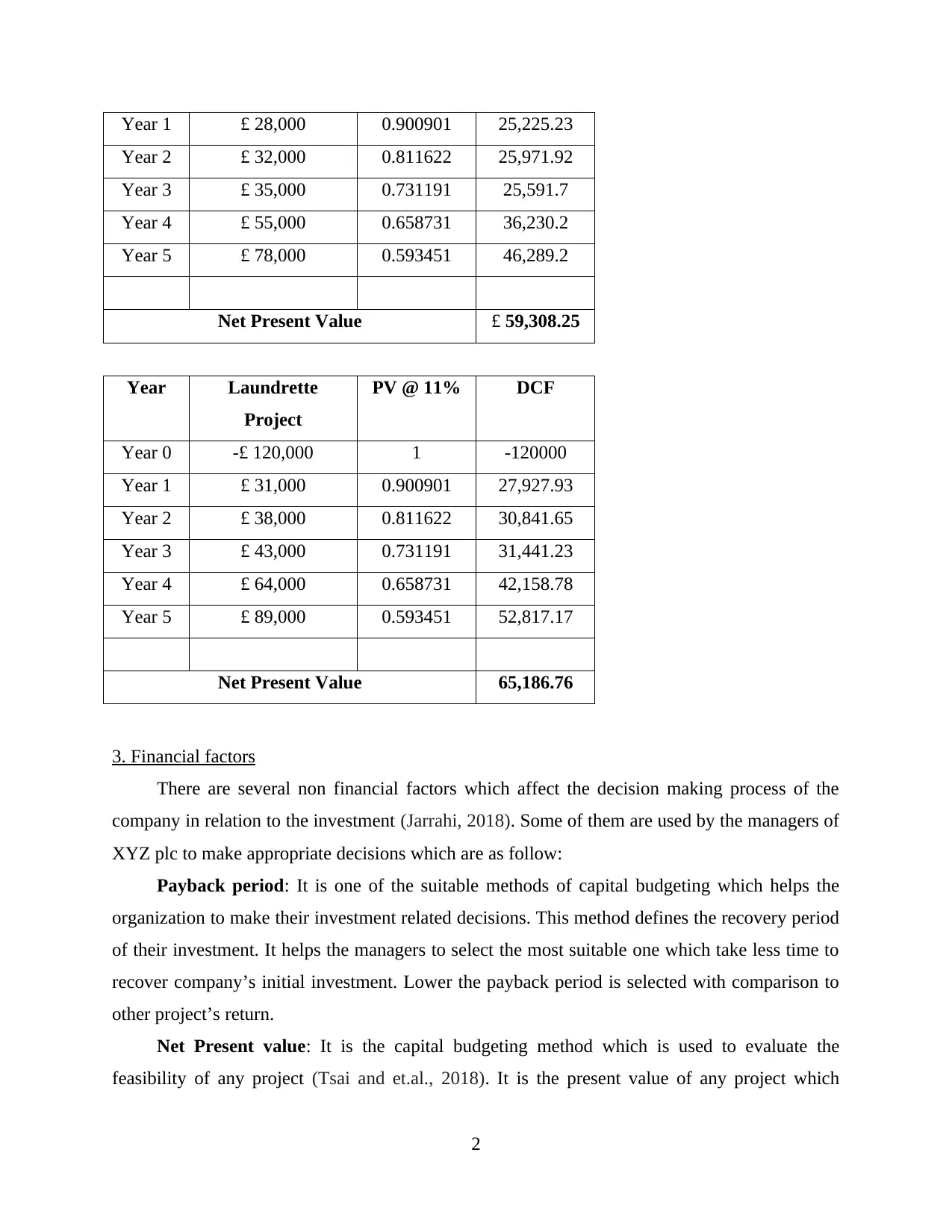
Year 1 £ 28,000 0.900901 25,225.23
Year 2 £ 32,000 0.811622 25,971.92
Year 3 £ 35,000 0.731191 25,591.7
Year 4 £ 55,000 0.658731 36,230.2
Year 5 £ 78,000 0.593451 46,289.2
Net Present Value £ 59,308.25
Year Laundrette
Project
PV @ 11% DCF
Year 0 -£ 120,000 1 -120000
Year 1 £ 31,000 0.900901 27,927.93
Year 2 £ 38,000 0.811622 30,841.65
Year 3 £ 43,000 0.731191 31,441.23
Year 4 £ 64,000 0.658731 42,158.78
Year 5 £ 89,000 0.593451 52,817.17
Net Present Value 65,186.76
3. Financial factors
There are several non financial factors which affect the decision making process of the
company in relation to the investment (Jarrahi, 2018). Some of them are used by the managers of
XYZ plc to make appropriate decisions which are as follow:
Payback period: It is one of the suitable methods of capital budgeting which helps the
organization to make their investment related decisions. This method defines the recovery period
of their investment. It helps the managers to select the most suitable one which take less time to
recover company’s initial investment. Lower the payback period is selected with comparison to
other project’s return.
Net Present value: It is the capital budgeting method which is used to evaluate the
feasibility of any project (Tsai and et.al., 2018). It is the present value of any project which
2
Year 2 £ 32,000 0.811622 25,971.92
Year 3 £ 35,000 0.731191 25,591.7
Year 4 £ 55,000 0.658731 36,230.2
Year 5 £ 78,000 0.593451 46,289.2
Net Present Value £ 59,308.25
Year Laundrette
Project
PV @ 11% DCF
Year 0 -£ 120,000 1 -120000
Year 1 £ 31,000 0.900901 27,927.93
Year 2 £ 38,000 0.811622 30,841.65
Year 3 £ 43,000 0.731191 31,441.23
Year 4 £ 64,000 0.658731 42,158.78
Year 5 £ 89,000 0.593451 52,817.17
Net Present Value 65,186.76
3. Financial factors
There are several non financial factors which affect the decision making process of the
company in relation to the investment (Jarrahi, 2018). Some of them are used by the managers of
XYZ plc to make appropriate decisions which are as follow:
Payback period: It is one of the suitable methods of capital budgeting which helps the
organization to make their investment related decisions. This method defines the recovery period
of their investment. It helps the managers to select the most suitable one which take less time to
recover company’s initial investment. Lower the payback period is selected with comparison to
other project’s return.
Net Present value: It is the capital budgeting method which is used to evaluate the
feasibility of any project (Tsai and et.al., 2018). It is the present value of any project which
2
Secure Best Marks with AI Grader
Need help grading? Try our AI Grader for instant feedback on your assignments.
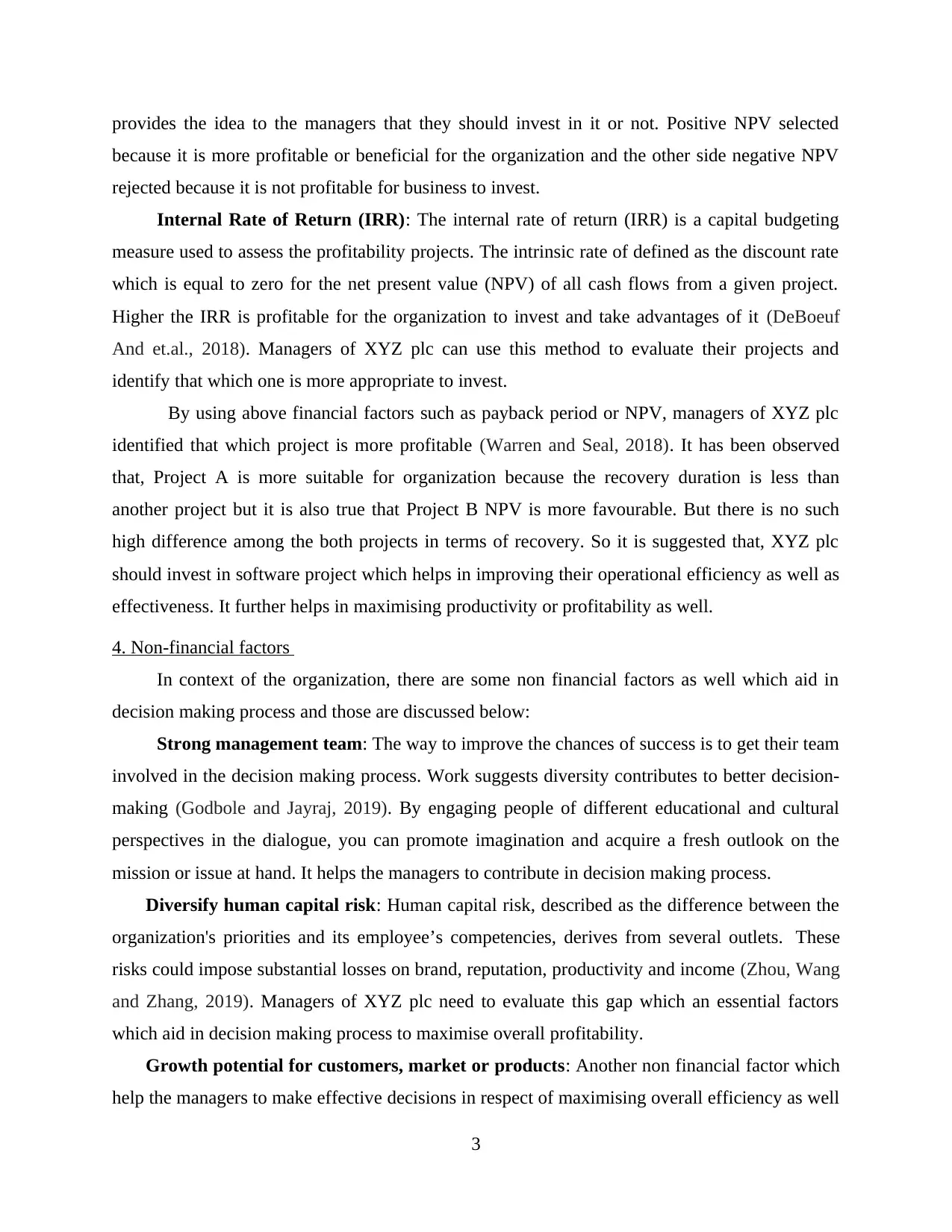
provides the idea to the managers that they should invest in it or not. Positive NPV selected
because it is more profitable or beneficial for the organization and the other side negative NPV
rejected because it is not profitable for business to invest.
Internal Rate of Return (IRR): The internal rate of return (IRR) is a capital budgeting
measure used to assess the profitability projects. The intrinsic rate of defined as the discount rate
which is equal to zero for the net present value (NPV) of all cash flows from a given project.
Higher the IRR is profitable for the organization to invest and take advantages of it (DeBoeuf
And et.al., 2018). Managers of XYZ plc can use this method to evaluate their projects and
identify that which one is more appropriate to invest.
By using above financial factors such as payback period or NPV, managers of XYZ plc
identified that which project is more profitable (Warren and Seal, 2018). It has been observed
that, Project A is more suitable for organization because the recovery duration is less than
another project but it is also true that Project B NPV is more favourable. But there is no such
high difference among the both projects in terms of recovery. So it is suggested that, XYZ plc
should invest in software project which helps in improving their operational efficiency as well as
effectiveness. It further helps in maximising productivity or profitability as well.
4. Non-financial factors
In context of the organization, there are some non financial factors as well which aid in
decision making process and those are discussed below:
Strong management team: The way to improve the chances of success is to get their team
involved in the decision making process. Work suggests diversity contributes to better decision-
making (Godbole and Jayraj, 2019). By engaging people of different educational and cultural
perspectives in the dialogue, you can promote imagination and acquire a fresh outlook on the
mission or issue at hand. It helps the managers to contribute in decision making process.
Diversify human capital risk: Human capital risk, described as the difference between the
organization's priorities and its employee’s competencies, derives from several outlets. These
risks could impose substantial losses on brand, reputation, productivity and income (Zhou, Wang
and Zhang, 2019). Managers of XYZ plc need to evaluate this gap which an essential factors
which aid in decision making process to maximise overall profitability.
Growth potential for customers, market or products: Another non financial factor which
help the managers to make effective decisions in respect of maximising overall efficiency as well
3
because it is more profitable or beneficial for the organization and the other side negative NPV
rejected because it is not profitable for business to invest.
Internal Rate of Return (IRR): The internal rate of return (IRR) is a capital budgeting
measure used to assess the profitability projects. The intrinsic rate of defined as the discount rate
which is equal to zero for the net present value (NPV) of all cash flows from a given project.
Higher the IRR is profitable for the organization to invest and take advantages of it (DeBoeuf
And et.al., 2018). Managers of XYZ plc can use this method to evaluate their projects and
identify that which one is more appropriate to invest.
By using above financial factors such as payback period or NPV, managers of XYZ plc
identified that which project is more profitable (Warren and Seal, 2018). It has been observed
that, Project A is more suitable for organization because the recovery duration is less than
another project but it is also true that Project B NPV is more favourable. But there is no such
high difference among the both projects in terms of recovery. So it is suggested that, XYZ plc
should invest in software project which helps in improving their operational efficiency as well as
effectiveness. It further helps in maximising productivity or profitability as well.
4. Non-financial factors
In context of the organization, there are some non financial factors as well which aid in
decision making process and those are discussed below:
Strong management team: The way to improve the chances of success is to get their team
involved in the decision making process. Work suggests diversity contributes to better decision-
making (Godbole and Jayraj, 2019). By engaging people of different educational and cultural
perspectives in the dialogue, you can promote imagination and acquire a fresh outlook on the
mission or issue at hand. It helps the managers to contribute in decision making process.
Diversify human capital risk: Human capital risk, described as the difference between the
organization's priorities and its employee’s competencies, derives from several outlets. These
risks could impose substantial losses on brand, reputation, productivity and income (Zhou, Wang
and Zhang, 2019). Managers of XYZ plc need to evaluate this gap which an essential factors
which aid in decision making process to maximise overall profitability.
Growth potential for customers, market or products: Another non financial factor which
help the managers to make effective decisions in respect of maximising overall efficiency as well
3
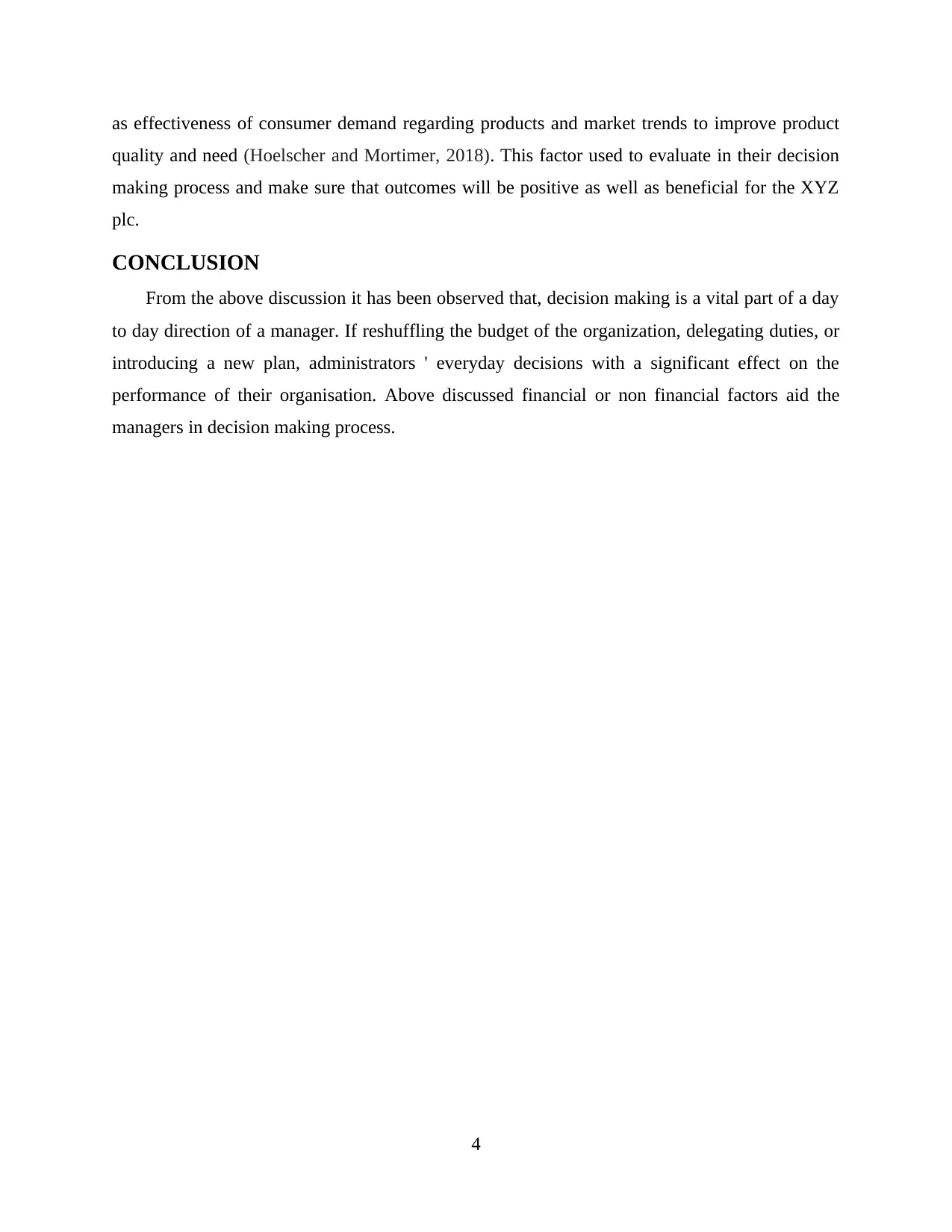
as effectiveness of consumer demand regarding products and market trends to improve product
quality and need (Hoelscher and Mortimer, 2018). This factor used to evaluate in their decision
making process and make sure that outcomes will be positive as well as beneficial for the XYZ
plc.
CONCLUSION
From the above discussion it has been observed that, decision making is a vital part of a day
to day direction of a manager. If reshuffling the budget of the organization, delegating duties, or
introducing a new plan, administrators ' everyday decisions with a significant effect on the
performance of their organisation. Above discussed financial or non financial factors aid the
managers in decision making process.
4
quality and need (Hoelscher and Mortimer, 2018). This factor used to evaluate in their decision
making process and make sure that outcomes will be positive as well as beneficial for the XYZ
plc.
CONCLUSION
From the above discussion it has been observed that, decision making is a vital part of a day
to day direction of a manager. If reshuffling the budget of the organization, delegating duties, or
introducing a new plan, administrators ' everyday decisions with a significant effect on the
performance of their organisation. Above discussed financial or non financial factors aid the
managers in decision making process.
4
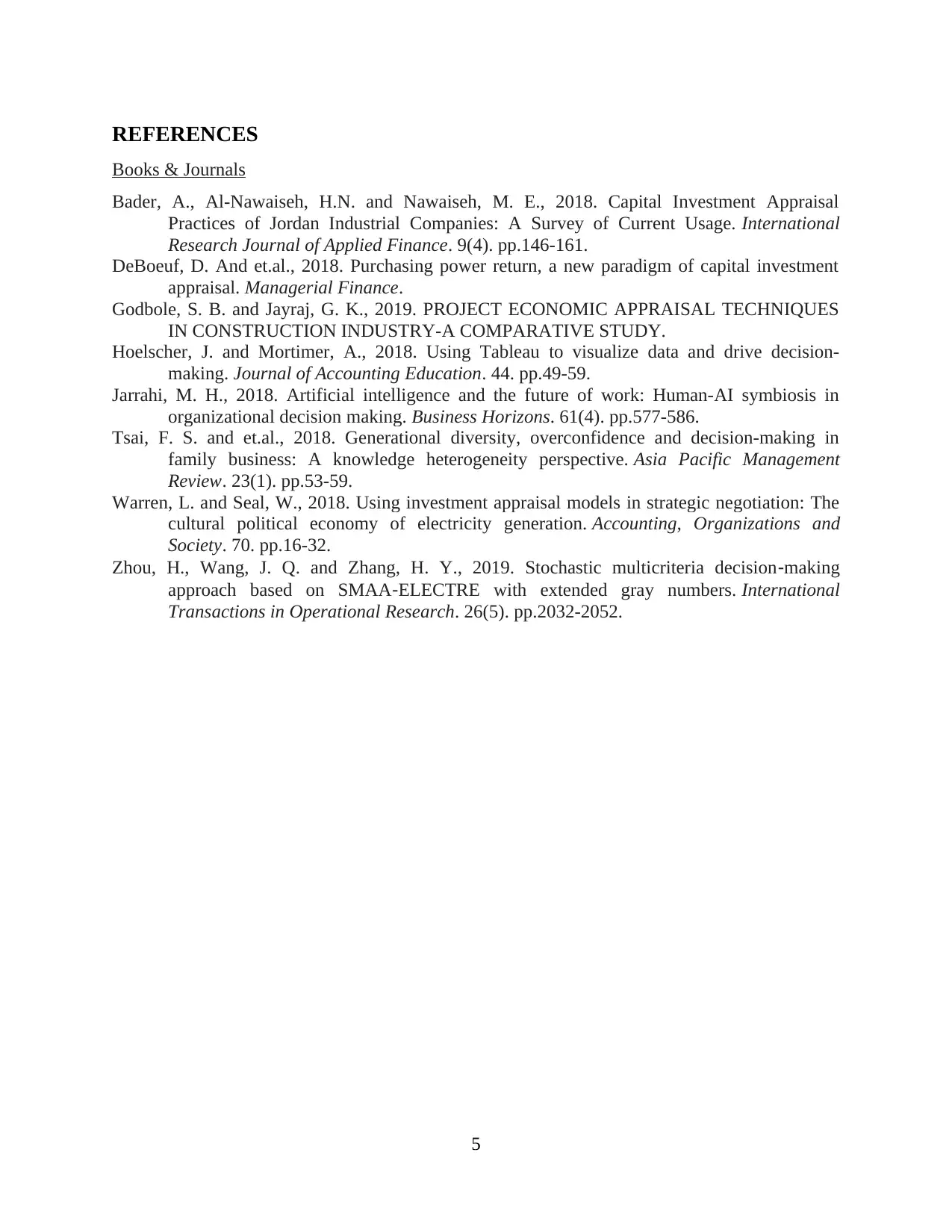
REFERENCES
Books & Journals
Bader, A., Al-Nawaiseh, H.N. and Nawaiseh, M. E., 2018. Capital Investment Appraisal
Practices of Jordan Industrial Companies: A Survey of Current Usage. International
Research Journal of Applied Finance. 9(4). pp.146-161.
DeBoeuf, D. And et.al., 2018. Purchasing power return, a new paradigm of capital investment
appraisal. Managerial Finance.
Godbole, S. B. and Jayraj, G. K., 2019. PROJECT ECONOMIC APPRAISAL TECHNIQUES
IN CONSTRUCTION INDUSTRY-A COMPARATIVE STUDY.
Hoelscher, J. and Mortimer, A., 2018. Using Tableau to visualize data and drive decision-
making. Journal of Accounting Education. 44. pp.49-59.
Jarrahi, M. H., 2018. Artificial intelligence and the future of work: Human-AI symbiosis in
organizational decision making. Business Horizons. 61(4). pp.577-586.
Tsai, F. S. and et.al., 2018. Generational diversity, overconfidence and decision-making in
family business: A knowledge heterogeneity perspective. Asia Pacific Management
Review. 23(1). pp.53-59.
Warren, L. and Seal, W., 2018. Using investment appraisal models in strategic negotiation: The
cultural political economy of electricity generation. Accounting, Organizations and
Society. 70. pp.16-32.
Zhou, H., Wang, J. Q. and Zhang, H. Y., 2019. Stochastic multicriteria decision‐making
approach based on SMAA‐ELECTRE with extended gray numbers. International
Transactions in Operational Research. 26(5). pp.2032-2052.
5
Books & Journals
Bader, A., Al-Nawaiseh, H.N. and Nawaiseh, M. E., 2018. Capital Investment Appraisal
Practices of Jordan Industrial Companies: A Survey of Current Usage. International
Research Journal of Applied Finance. 9(4). pp.146-161.
DeBoeuf, D. And et.al., 2018. Purchasing power return, a new paradigm of capital investment
appraisal. Managerial Finance.
Godbole, S. B. and Jayraj, G. K., 2019. PROJECT ECONOMIC APPRAISAL TECHNIQUES
IN CONSTRUCTION INDUSTRY-A COMPARATIVE STUDY.
Hoelscher, J. and Mortimer, A., 2018. Using Tableau to visualize data and drive decision-
making. Journal of Accounting Education. 44. pp.49-59.
Jarrahi, M. H., 2018. Artificial intelligence and the future of work: Human-AI symbiosis in
organizational decision making. Business Horizons. 61(4). pp.577-586.
Tsai, F. S. and et.al., 2018. Generational diversity, overconfidence and decision-making in
family business: A knowledge heterogeneity perspective. Asia Pacific Management
Review. 23(1). pp.53-59.
Warren, L. and Seal, W., 2018. Using investment appraisal models in strategic negotiation: The
cultural political economy of electricity generation. Accounting, Organizations and
Society. 70. pp.16-32.
Zhou, H., Wang, J. Q. and Zhang, H. Y., 2019. Stochastic multicriteria decision‐making
approach based on SMAA‐ELECTRE with extended gray numbers. International
Transactions in Operational Research. 26(5). pp.2032-2052.
5
1 out of 7
Related Documents
Your All-in-One AI-Powered Toolkit for Academic Success.
+13062052269
info@desklib.com
Available 24*7 on WhatsApp / Email
![[object Object]](/_next/static/media/star-bottom.7253800d.svg)
Unlock your academic potential
© 2024 | Zucol Services PVT LTD | All rights reserved.





